Travis County Master Gardeners Track Winter Freeze Recovery Process
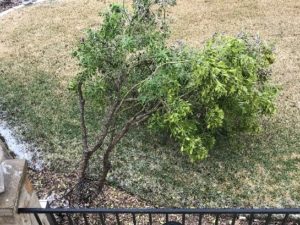
Fallen trees and frozen foliage was a common sight
Numerous landscape plants and trees were toppled by the freezing rain and snow sent by Winter Storm Uri in February, with most plant foliage becoming brown and crispy within days or weeks. Homeowners and gardeners wondered – do we have to start over with the landscape, and how much is all this going to cost? Can we even find the plants we’d like to buy? The Travis County Master Gardeners had the same questions, and researched the progress of over 50 native and adapted plant/tree species post the impact of February’s freeze. Record sustained temperatures below freezing tested many new and mature plantings with varied results. The research will continue for long-term impacts. However, we’re got sufficient evidence to share with you as we enter the current winter season.
Key Themes for Winter Storm Uri Survivors
The gardeners determined that each specimen has it’s own story as to why it survived or failed. However, looking at the entire group of research, three key themes emerged:
- Microclimates matter. The microclimate directly impacted the speed of specimen recovery. Local factors such as sun exposure, wind protection, southern exposure, and age/maturity played a significant role in the recovery of the specimen. This explains why some trees and plants died while others flourished. Exposure to the northwest winds caused many trees and plants to lose branches, or completely topple over in the weight of the frozen rain and snow.
- Natives performed splendidly. Perennials and natives/adapted specimens had very few issues. In fact, the winter temperatures seemed to have given a needed break, or dormancy period, readying the plant for spring growth. Most rose varieties bloomed profusely in the springtime – a gift after such a frigid winter.
- Container plants suffered. If not brought indoors for protection, most plants contained within pots suffered irreparable damage to the root systems and perished, without regard to age or health. Even after ensuring the container had been watered and the plant covered, the brutal temperatures froze most root balls to a point that recovery was not an option. Many citrus trees were lost since container gardening is a popular solution for the Austin area.
Freeze? What Freeze?
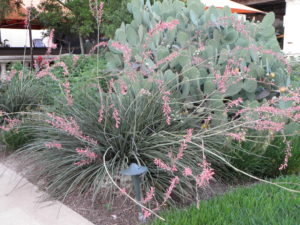
Hesperaloe parviflora proved resilient to Winter Storm Uri
While most plant specimens showed a negative impact from the freezing temperatures, there emerged a big landscape winner from Winter Storm Uri, the Red Yucca (Hesperaloe parviflora), also known as the Hummingbird Yucca. This hardy specimen remained evergreen, bloomed right on time in the spring, continued blooming all summer long, and continued to propagate itself with offsets. Staying true to its ‘maintenance free’ description, the specimen is an excellent choice as a small to medium-sized landscape selection. Although normally small when purchased, it grows rather quickly in our hot arid climate, so give it plenty of room to expand. At maturity, this variety can easily grow to 3-5 ft. in width.
Death begot Life
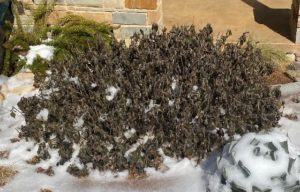 |
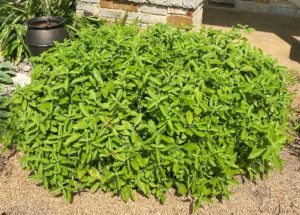 |
|
Mexican Honeysuckle (Justicia spicigera) in February and again in September 2021 |
|
While several of the researched specimens perished, another common theme emerged. With mature (typically greater than 5 years) specimens, new life emerged from the root zone. Where a specimen may have survived, additional growth was often noted emerging from the base. In most cases, the surviving plant reached a size equal or greater than that prior to the freeze by mid-to-late summer. It appears the energy normally used to sustain the foliage on mature plants was used to reproduce and rebuild the plants – often with more stems than the original specimen. And we cannot forget about the bulbs, which normally take a break during the winter months. The freeze invigorated many with profuse blooms, but some skipped their normal spring cycle, instead shooting up extensive green foliage in lieu of the flower.
What Next?
The lesson learned is nature rebounds, and in the case of our local yards, quicker and with greater resilience than most expected. The Travis County Master Gardeners will continue to track local native and adapted specimens and publish future blogs on specific specimens for current and future gardener reference. Have a question about a specific plant or tree? Contact the Travis County Master Gardener Helpdesk at travismg@ag.tamu.edu.
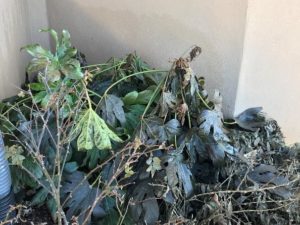 |
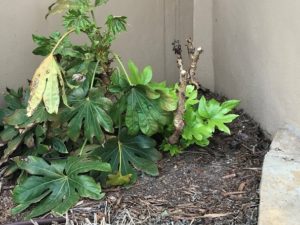 |
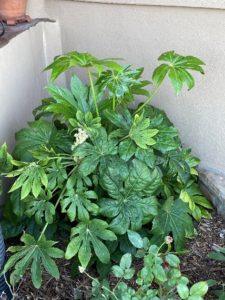 |
|
Japanese Aralia (Fatsia japonica) in February, April, and again in October 2021 |
||
Additional Resources
Other Posts on this topic:
- Plant Freeze Recovery Tips
- Huisache – the 2021 Winter Storm Survivor
- Variegated Ginger – Surprising 2021 Winter Storm Survivor by Kirk Walden
- Novice Perennial Planter Meets the 2021 Winter Storm by Linda Burch
- Mexican Honeysuckle – First Responder from the 2021 Winter Storm by Kirk Walden
Weather Strategies for Austin Gardens
Native and Adapted Landscape Plants searchable database
Climate Graph for Austin Bergstrom
About Yvonne Schneider

Yvonne was a 35+year veteran in the computer and information technology industry when she retired and moved from Houston to the Austin area. In 2018, Yvonne certified as a Travis County Texas Master Gardener to follow her passion for gardening and volunteering within the community. She has spent 20+ years enjoying gardening and working with bulbs and perennials. She now tackles the challenges presented by the Austin area wildlife, drought, and limestone soil.
